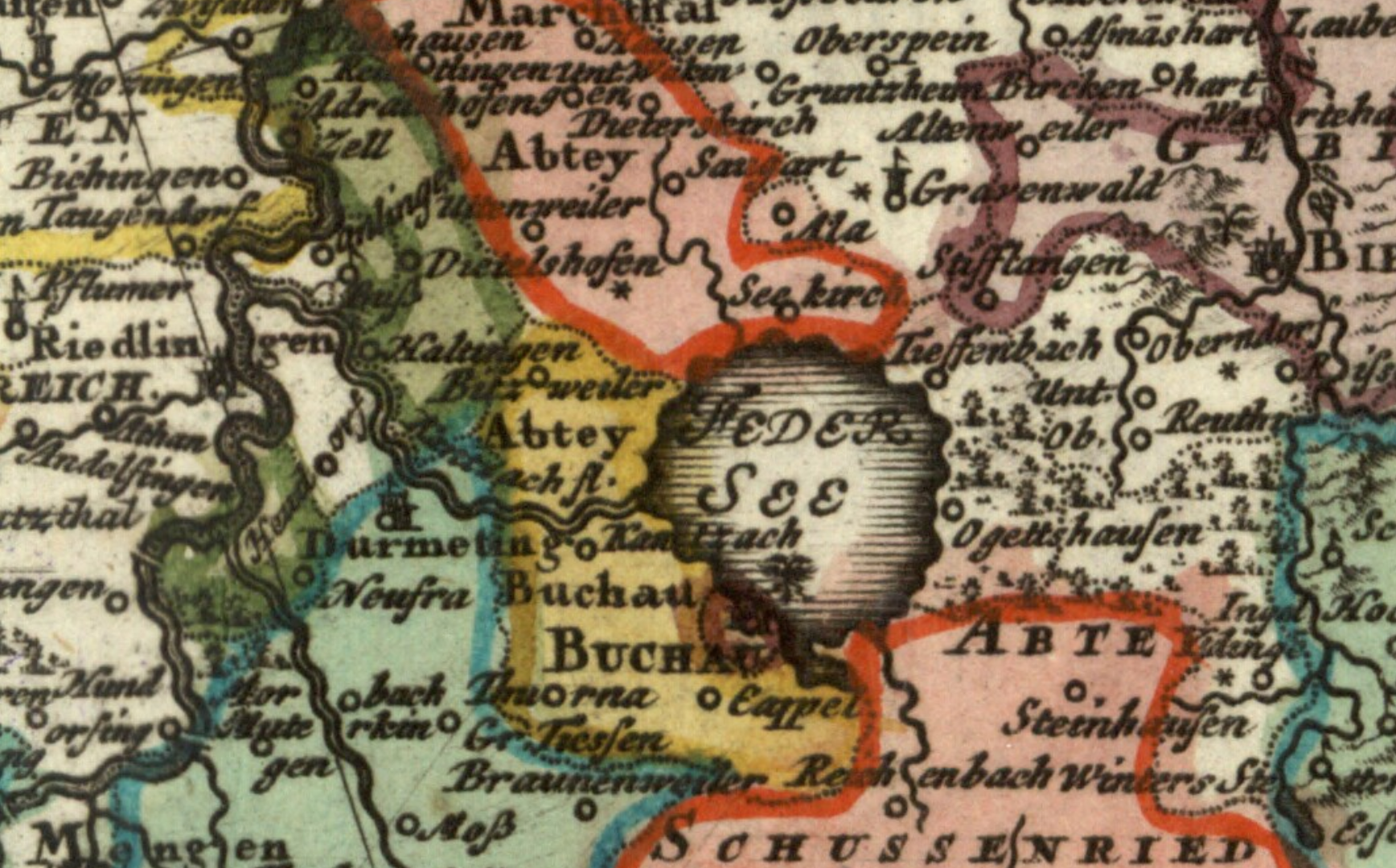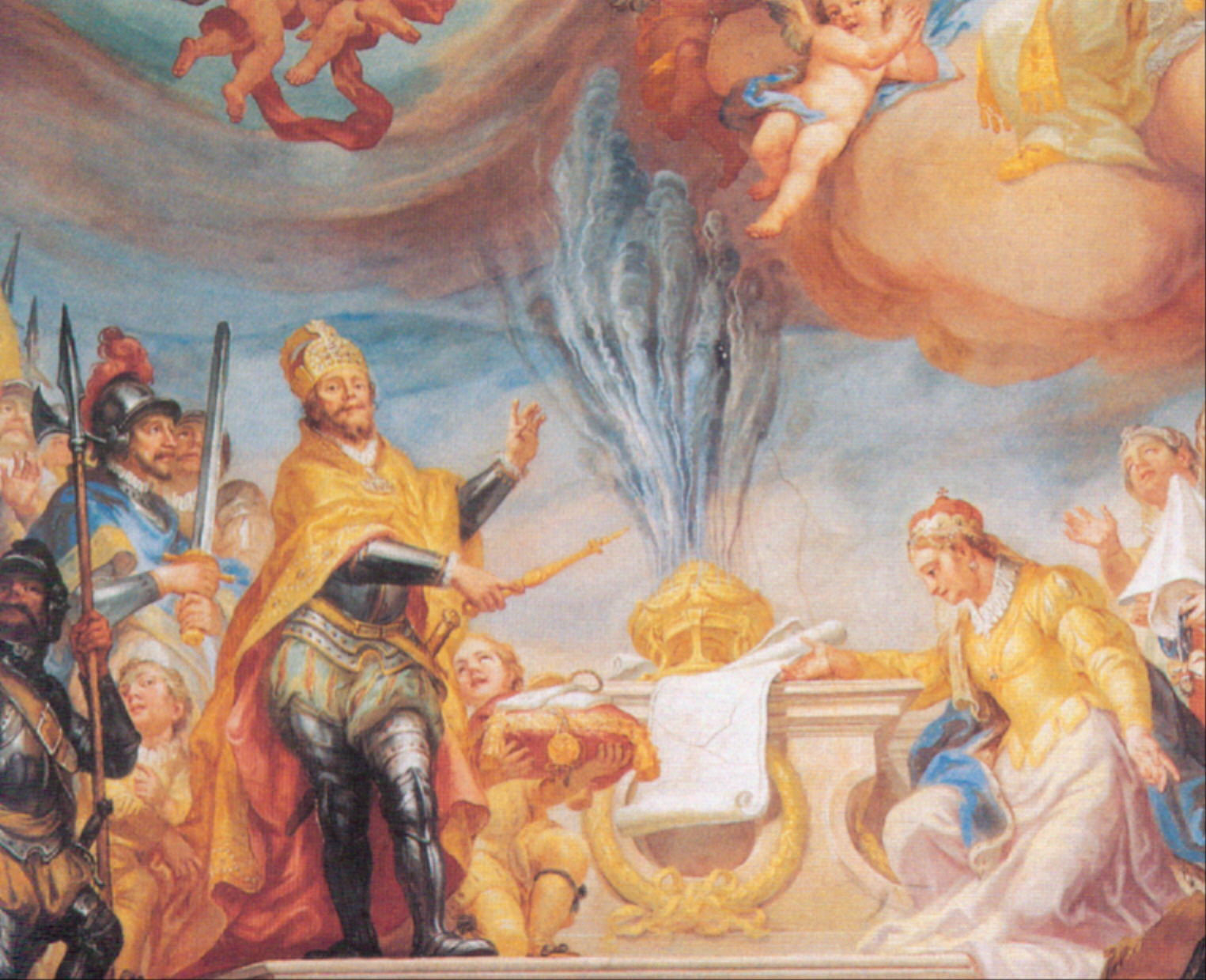Buchau Abbey on:
[Wikipedia]
[Google]
[Amazon]
Buchau Abbey, otherwise the Imperial Abbey of Buchau (german: Reichsstift Buchau), was initially a community of canonesses regular, and later a collegiate foundation of secular canonesses, in Buchau (now 
 The abbey was initially a house of canonesses regular, but at a later date it was converted into a collegiate foundation of secular canonesses who belonged to various noble families of Swabia. In 1347, Buchau Abbey gained
The abbey was initially a house of canonesses regular, but at a later date it was converted into a collegiate foundation of secular canonesses who belonged to various noble families of Swabia. In 1347, Buchau Abbey gained 
full text on Wikisource
* Rudolf Seigel (ed.): ''Die Urkunden des Stifts Buchau. Regesten 819–1500''. (= "Inventare der nichtstaatlichen Archive in Baden-Württemberg"; Bd. 36). Kohlhammer, Stuttgart 2009 * Bernhard Theil: ''Das (freiweltliche) Damenstift Buchau am Federsee''. (= "Germania sacra", N. F., Bd. 32; ''Das Bistum Konstanz, Teil 4''), publ. Max-Planck-Institut für Geschichte. De Gruyter, Berlin 1994.p. 422 () * Volker Himmelein (ed.): ''Alte Klöster, neue Herren. Die Säkularisation im deutschen Südwesten 1803. Große Landesausstellung Baden-Württemberg 2003''; Ostfildern: Thorbecke, 2003 (exhibition catalogue and collection of essays)
Klöster in Baden-Württemberg: Adelige Chorfrauenstift Buchau -Geschichte
*
* , by Bernhard Theil, 1994. {{Authority control Monasteries in Baden-Württemberg Augustinian monasteries in Germany Monasteries of Canonesses Regular Christian monasteries established in the 8th century 8th-century establishments in Germany Imperial abbeys disestablished in 1802–03 1340s establishments in the Holy Roman Empire 1347 establishments in Europe 1803 disestablishments in the Holy Roman Empire Buildings and structures in Biberach (district) Württemberg Churches completed in 770 8th-century churches in Germany
Bad Buchau
Bad Buchau () (formerly Buchau; Swabian: ''Buacha'') is a small town in the district of Biberach, Baden-Württemberg, Germany with about 4,000 inhabitants. It is situated near Lake Federsee, which is separated from the town by a wide reed belt. ...
) in Baden-Württemberg
Baden-Württemberg (; ), commonly shortened to BW or BaWü, is a German state () in Southwest Germany, east of the Rhine, which forms the southern part of Germany's western border with France. With more than 11.07 million inhabitants across a ...
, Germany. The abbey was a self-ruling Imperial Estate
An Imperial State or Imperial Estate ( la, Status Imperii; german: Reichsstand, plural: ') was a part of the Holy Roman Empire with representation and the right to vote in the Imperial Diet ('). Rulers of these Estates were able to exercise si ...
and its abbess had seat and vote at the Imperial Diet.
According to tradition, the monastery was founded around 770 on an island in the Federsee
Federsee is a lake located just north of Bad Buchau in the region of Upper Swabia in Southern Germany. It is surrounded by moorland, partially overgrown with reeds. With a size of 33 km2 (8,155 acres), the area is one of the largest, grou ...
by the Frankish
Frankish may refer to:
* Franks, a Germanic tribe and their culture
** Frankish language or its modern descendants, Franconian languages
* Francia, a post-Roman state in France and Germany
* East Francia, the successor state to Francia in Germany ...
Count Warin and his wife Adelindis (still commemorated in the local ''Adelindisfest''). The abbey was put on a secure financial footing by Louis the Pious
Louis the Pious (german: Ludwig der Fromme; french: Louis le Pieux; 16 April 778 – 20 June 840), also called the Fair, and the Debonaire, was King of the Franks and co-emperor with his father, Charlemagne, from 813. He was also King of Aqui ...
, who in 819 granted the nuns property in the Saulgau and in Mengen. In 857, Louis the German
Louis the German (c. 806/810 – 28 August 876), also known as Louis II of Germany and Louis II of East Francia, was the first king of East Francia, and ruled from 843 to 876 AD. Grandson of emperor Charlemagne and the third son of Louis the P ...
declared it a private religious house of the Carolingian Imperial family and appointed as abbess his daughter Irmingard (died 16 July 866).

 The abbey was initially a house of canonesses regular, but at a later date it was converted into a collegiate foundation of secular canonesses who belonged to various noble families of Swabia. In 1347, Buchau Abbey gained
The abbey was initially a house of canonesses regular, but at a later date it was converted into a collegiate foundation of secular canonesses who belonged to various noble families of Swabia. In 1347, Buchau Abbey gained Imperial immediacy
Imperial immediacy (german: Reichsfreiheit or ') was a privileged constitutional and political status rooted in German feudal law under which the Imperial estates of the Holy Roman Empire such as Imperial cities, prince-bishoprics and secular pri ...
and the abbess was raised to the rank of Princess-Abbess
A prince-abbot (german: Fürstabt) is a title for a clergy, cleric who is a Prince of the Church (like a Prince-bishop), in the sense of an ''ex officio'' temporal lord of a feudalism, feudal entity, usually a Imperial State, State of the Holy R ...
. The abbey was an Imperial Estate
An Imperial State or Imperial Estate ( la, Status Imperii; german: Reichsstand, plural: ') was a part of the Holy Roman Empire with representation and the right to vote in the Imperial Diet ('). Rulers of these Estates were able to exercise si ...
and its abbess had seat and vote at the Imperial Diet.
Also in the 13th century the town of Buchau, which had grown up in the immediate vicinity of the abbey, gained the status of a Free imperial city
In the Holy Roman Empire, the collective term free and imperial cities (german: Freie und Reichsstädte), briefly worded free imperial city (', la, urbs imperialis libera), was used from the fifteenth century to denote a self-ruling city that ...
after a long period of strife between the townspeople and the abbey. From then on and until 1803, Buchau Abbey and the Imperial City of Buchau, both self-governing entities fully independent of each other, were forced to coexist. Unlike most of the other Free Imperial Cities, Buchau was to remain Catholic in the course of the Reformation.
In 1415, the abbey became a secular foundation and from then on the congregation was to be composed of an abbess, twelve canonesses choral (choir women or ''Chorfrauen'') and two chaplains. The abbess, as head of an Imperial Estate
An Imperial State or Imperial Estate ( la, Status Imperii; german: Reichsstand, plural: ') was a part of the Holy Roman Empire with representation and the right to vote in the Imperial Diet ('). Rulers of these Estates were able to exercise si ...
, had seat and voice in the Reichstag. Buchau Abbey had a small territorial base and in 1625 the lordship of Strassberg also became part of the abbey's possessions.
In the course of the secularisation
In sociology, secularization (or secularisation) is the transformation of a society from close identification with religious values and institutions toward non-religious values and secular institutions. The ''secularization thesis'' expresses the ...
of 1803, Buchau Abbey was dissolved like all the other Imperial abbeys and its territory and assets passed first to the prince of Thurn und Taxis
The Princely House of Thurn and Taxis (german: link=no, Fürstenhaus Thurn und Taxis ) is a family of German nobility that is part of the ''Briefadel''. It was a key player in the postal services in Europe during the 16th century, until the en ...
, then to the Kingdom of Württemberg
The Kingdom of Württemberg (german: Königreich Württemberg ) was a German state that existed from 1805 to 1918, located within the area that is now Baden-Württemberg. The kingdom was a continuation of the Duchy of Württemberg, which existe ...
in 1806. The lordship of Strassberg however was annexed to the Principality of Hohenzollern-Sigmaringen
( en, Nothing without God)
, national_anthem =
, common_languages = German
, religion = Roman Catholic
, currency =
, title_leader = Prince
, leader1 ...
.
The abbey church of Saints Cornelius and Cyprian
Cyprian (; la, Thaschus Caecilius Cyprianus; 210 – 14 September 258 AD''The Liturgy of the Hours according to the Roman Rite: Vol. IV.'' New York: Catholic Book Publishing Company, 1975. p. 1406.) was a bishop of Carthage and an early Christ ...
, one of the first neo-classical buildings in southern Germany and still showing some late Baroque features, was built between 1774 and 1776 by Pierre Michel d'Ixnard as a conversion and refurbishment of a Gothic
Gothic or Gothics may refer to:
People and languages
*Goths or Gothic people, the ethnonym of a group of East Germanic tribes
**Gothic language, an extinct East Germanic language spoken by the Goths
**Crimean Gothic, the Gothic language spoken b ...
church. It includes stucco sculptures by Johann Joseph Christian.

References
Further reading
* Johann Daniel Georg v. Memminger: ''Stift Buchau, aus Beschreibung des Oberamts Riedlingen''. Cotta, Stuttgart and Tübingen 1827full text on Wikisource
* Rudolf Seigel (ed.): ''Die Urkunden des Stifts Buchau. Regesten 819–1500''. (= "Inventare der nichtstaatlichen Archive in Baden-Württemberg"; Bd. 36). Kohlhammer, Stuttgart 2009 * Bernhard Theil: ''Das (freiweltliche) Damenstift Buchau am Federsee''. (= "Germania sacra", N. F., Bd. 32; ''Das Bistum Konstanz, Teil 4''), publ. Max-Planck-Institut für Geschichte. De Gruyter, Berlin 1994.p. 422 () * Volker Himmelein (ed.): ''Alte Klöster, neue Herren. Die Säkularisation im deutschen Südwesten 1803. Große Landesausstellung Baden-Württemberg 2003''; Ostfildern: Thorbecke, 2003 (exhibition catalogue and collection of essays)
External links
* *Klöster in Baden-Württemberg: Adelige Chorfrauenstift Buchau -Geschichte
*
* , by Bernhard Theil, 1994. {{Authority control Monasteries in Baden-Württemberg Augustinian monasteries in Germany Monasteries of Canonesses Regular Christian monasteries established in the 8th century 8th-century establishments in Germany Imperial abbeys disestablished in 1802–03 1340s establishments in the Holy Roman Empire 1347 establishments in Europe 1803 disestablishments in the Holy Roman Empire Buildings and structures in Biberach (district) Württemberg Churches completed in 770 8th-century churches in Germany